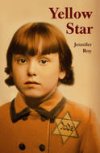Yellow Star by Jennifer Roy

Frances Lincoln Children's Books, 2009.
ISBN 9781845079086
(Ages 12+) When her aunt Sylvia told her of her childhood in the Jewish
ghetto in Lodz, Poland, Jennifer Roy had to write it down. She toyed
with a non fiction book, and then a fictionalized account in the third
person, finally settling on a verse novel told in the first person. It
is most successful. Told from a child's perspective, the horror is made
more real by the simple way it is told, without embellishment. And it
is Sylvia's story from start to finish, coming from taped interviews
with her aunt, Jennifer Roy has faithfully retold the story of the
270,000 people who became the 800 survivors of this horrific place.
In between the diary like entries, Roy gives us a potted history of the
events for that year, so the reader has a good idea of the progress of
the war and what is happening outside Lodz. What is happening inside
that city is claustrophobic and dehumanizing, as we read of parents
torn from their children, people starving to death, adults made to work
in the factories still active in Lodz.
Sylvia's father was able to protect himself and his family and some of
his siblings, by watching what was going on. The remnant Nazi force,
getting ready to shoot them all, still had to clean up the ghetto, and
so wanted men to stay and clean. The lists they had of these people,
her father noted, were not lists at all, and so he was able to give his
name and that of his wider family to the soldiers and so pass into some
safety.
But at the end, hailed by some of the Russian army, the few left were
overwhelmed that they were rescued by a major, a Jewish major, who when
his planes were bombing the ghetto, noticed the light reflecting from
the yellow stars on their clothes and so stopped the planes, landing
and then coming to search for those he saw. It is a powerful
story, one which will enthrall those readers irrespective of what they
know of the holocaust. This story gives information about what it was
like in one ghetto, and for one family, but gives the story of them all
in bleak and simple words. For those looking at historical fiction, or
diary stories, or stories of the holocaust, then this is a salutary
read for middle school students.
Fran Knight